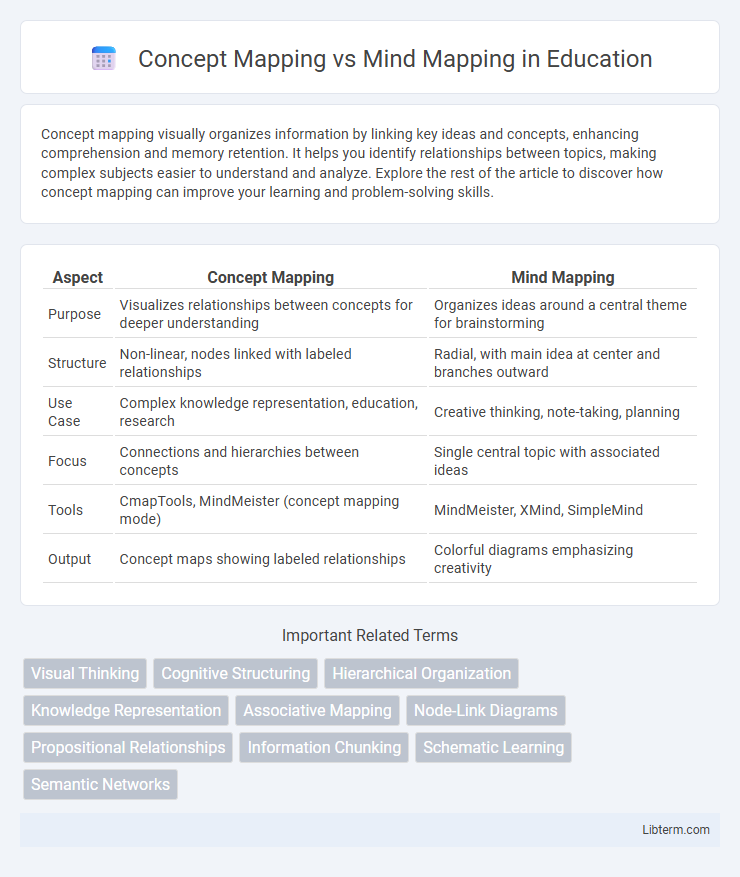Concept mapping visually organizes information by linking key ideas and concepts, enhancing comprehension and memory retention. It helps you identify relationships between topics, making complex subjects easier to understand and analyze. Explore the rest of the article to discover how concept mapping can improve your learning and problem-solving skills.
Table of Comparison
| Aspect | Concept Mapping | Mind Mapping |
|---|---|---|
| Purpose | Visualizes relationships between concepts for deeper understanding | Organizes ideas around a central theme for brainstorming |
| Structure | Non-linear, nodes linked with labeled relationships | Radial, with main idea at center and branches outward |
| Use Case | Complex knowledge representation, education, research | Creative thinking, note-taking, planning |
| Focus | Connections and hierarchies between concepts | Single central topic with associated ideas |
| Tools | CmapTools, MindMeister (concept mapping mode) | MindMeister, XMind, SimpleMind |
| Output | Concept maps showing labeled relationships | Colorful diagrams emphasizing creativity |
Introduction to Concept Mapping and Mind Mapping
Concept mapping organizes information visually by illustrating relationships between concepts using nodes and linking phrases, enhancing comprehension and knowledge retention. Mind mapping centers on generating ideas radiating from a central theme, promoting creativity through hierarchical branching of keywords and images. Both techniques serve distinct cognitive purposes, with concept maps emphasizing structured understanding and mind maps fostering brainstorming and free association.
Defining Concept Mapping
Concept mapping is a visual tool used to represent relationships between ideas through nodes and labeled connections, emphasizing hierarchical organization and meaningful links. It helps in structuring knowledge by showing how concepts interrelate within a broader context, making it ideal for complex subjects. Unlike mind mapping, concept maps focus more on illustrating detailed relationships rather than radial brainstorming.
Defining Mind Mapping
Mind mapping is a visual tool that organizes information around a central concept, using branches to represent related ideas, keywords, and images, enhancing creativity and memory. It facilitates brainstorming by allowing free-flowing associations and hierarchical structuring, making complex topics easier to understand and remember. Unlike concept mapping, which emphasizes relationships and cross-links between concepts, mind mapping centers on radiating connections from a single focal point.
Key Similarities Between Concept Mapping and Mind Mapping
Concept mapping and mind mapping both facilitate visual organization of information, enhancing comprehension and memory retention. Each technique uses nodes connected by lines to represent relationships, making abstract ideas easier to understand and analyze. Both methods support brainstorming, problem-solving, and learning by visually structuring complex concepts and their interconnections.
Core Differences Between Concept Maps and Mind Maps
Concept maps visually represent relationships between ideas through interconnected nodes and labeled links, emphasizing hierarchical structure and complex connections. Mind maps center around a single central idea with radiating branches, prioritizing brainstorming and creativity without explicitly defining the relationships between nodes. The core difference lies in concept maps' focus on detailed relational semantics, whereas mind maps facilitate intuitive organization and idea generation.
When to Use Concept Mapping
Concept mapping is ideal for organizing complex information with hierarchical relationships and cross-links between ideas, making it useful in academic research, curriculum design, and knowledge management. It helps visualize connections among concepts to promote deeper understanding and critical thinking in subjects like science and social studies. When the goal is to clarify relationships, structure detailed content, or brainstorm interconnected ideas systematically, concept mapping offers a comprehensive and structured approach compared to mind mapping.
When to Use Mind Mapping
Mind mapping is ideal for brainstorming sessions and organizing ideas visually with a clear hierarchical structure, making it easier to capture and connect thoughts quickly. It works well for note-taking, project planning, and outlining topics where simplicity and creativity are key. When detailed relationships and complex connections between concepts are not the priority, mind mapping offers a straightforward, intuitive approach to idea generation.
Popular Tools for Concept and Mind Mapping
Popular tools for concept mapping include CmapTools, which offers advanced features for creating complex relationships and collaborative work, and Lucidchart, known for its versatile diagramming capabilities and cloud-based accessibility. Mind mapping tools such as MindMeister and XMind provide intuitive interfaces designed for brainstorming and visual organization, incorporating templates and real-time collaboration features to enhance creativity. These platforms cater to distinct cognitive processes: concept mapping emphasizes structured knowledge representation, while mind mapping focuses on idea generation and hierarchical organization.
Benefits and Limitations of Each Approach
Concept mapping enhances understanding by visually organizing relationships between complex ideas and promotes critical thinking through hierarchical structures, but its complexity can overwhelm beginners and requires more time to create. Mind mapping boosts creativity and memory retention by encouraging freeflowing associations and intuitive visualization of ideas, yet it may lack the depth needed for detailed analysis and can lead to cluttered diagrams if not carefully managed. Choosing between the two depends on the user's need for structured knowledge representation or flexible idea generation.
Conclusion: Choosing the Right Mapping Technique
Choosing between concept mapping and mind mapping depends on the purpose and complexity of the information. Concept mapping excels at illustrating relationships and hierarchical structures among ideas, making it ideal for detailed analysis and academic learning. Mind mapping offers a more flexible, radial layout suited for brainstorming and visualizing ideas quickly, enhancing creativity and rapid organization.
Concept Mapping Infographic

 libterm.com
libterm.com